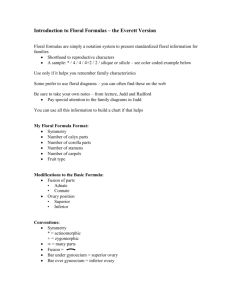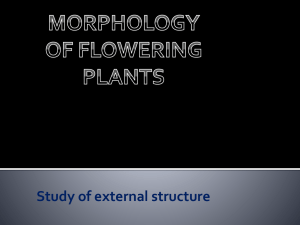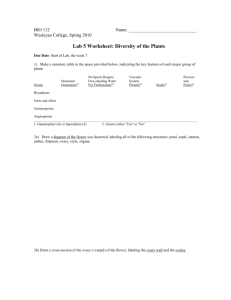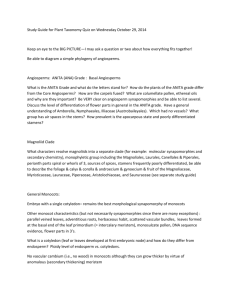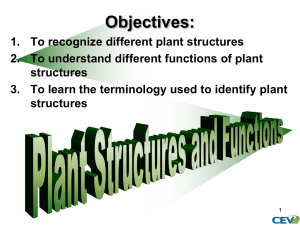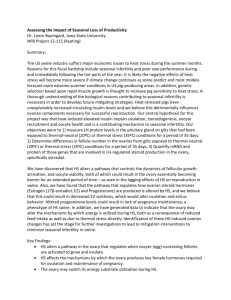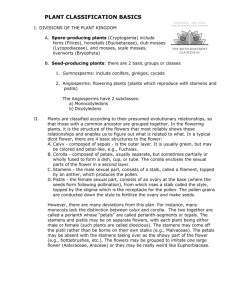Lecture 1
advertisement
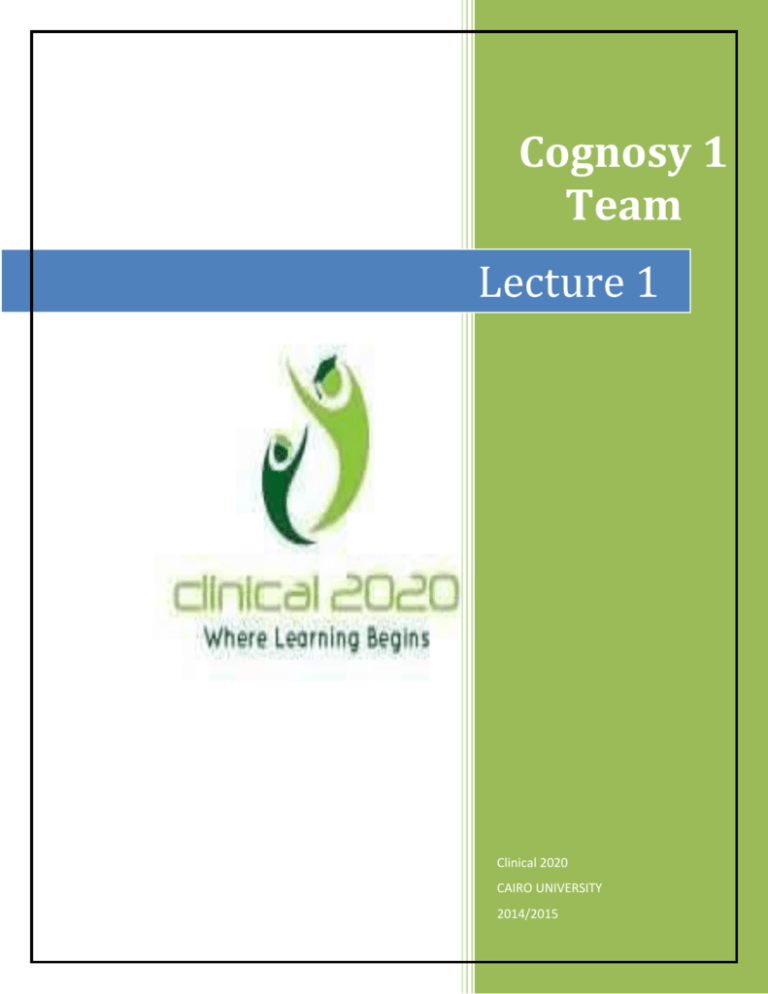
Cognosy 1 Team Lecture 1 Clinical 2020 CAIRO UNIVERSITY 2014/2015 Before we start we like to know that our course will be about Flower ( e.g. Karkadeh ) Bract ( e.g. Cinnamon ) Wood Herbs ( e.g. Menta) Definition of Flower: a modified fertile shoot carrying modified leaves adapted for reproduction. - Consists of Calyx Corolla, Androecium Gynoecium - Carried on a receptacle: swollen apex of flower stalk - Bract: Is a leafy structure from the axil of which arise the flowers. - Involucre: group of bracts arranged in one or more whorls surrounding the inflorescence inflorescence: group of flowers Note: Involucre is the modification of bract - Receptacle: swollen or expanded apex of flower below calyx & ovary. - Hypanthium: is an elongated receptacle below the Calyx & Ovary ( e.g.: clove) Floral leaves Asexual Sexual (essential) ( non-essential) Calyx Corolla Androecium Filament Anther Page 2 Gynoecium Ovary Style Stigma Kinds of flowers According to arrangement of floral leaves on the floral axis Cyclic the floral parts are arranged in definite whorls around the axis of the flower e.g.: clove Acyclic floral parts are arranged in spirals and not in whorls According to the symmetry of all floral parts Regular Irregular Segments are alike , regularly arranged Segments are not alike,( irregular) Actinomorphic Segments could be divided into equal halves by longitudinal cuts Asymmetric Segments could not be divided into equal halves(segments are irregularly arranged) Zygomorphic Could be divided into equal halves in only one plane e.g.: ray floret in Asteraceae According to the presence or absence of sexual organs Complete (perfect) Incomplete (imperfect) Calyx , corolla , androecium, gynoecium (Hermaphrodite ) Lacking calyx or corolla Unisexual Neutral Either Androecium or Gynoecium Pistillate Staminate Neither androecium nor gynoecium Only Gynoecium Page 3 Only Androeciu Plants of Flowers Monoecious Dioecious - 1 house Both male and female flowers on the same plant - 2 houses Male and female on separate plants e.g.: palms Polygamous Both male and female (hermaphrodite) on the same plant Perianth : is the outer non-essential floral parts when they are not differentiated into calyx and corolla (all the segments are alike ) It may be: Sepaloid: green in color Petaloid: colored Calyx Is the outermost whorl of floral parts that protects the essential organs Cohesion of Sepals Polyseoalous Aposepalous (free sepals) as in cruciferae Gamosepalous Synsepalous (united sepals) as in solanaceae Pappus Rudimentary modified calyx represented by bristles شعيراتinstead of sepals. Bristles: Are hard, rough hairs Each bristle consists of 4-5 cells in diameter one cell at the apex e.g.: Arnica (30 bristles forming the pappus) Epicalyx Stipules of stipulate calyx fuse in pairs between the sepals producing an outer serious of small sepal like structure. e.g.: family Rosaceae OR: Bracts, bracteoles aggregated beneath the calyx forming the epicalyx. e.g.: Karkade ( family Malvaceae ) Page 4 Corolla Inner whorl of the floral parts which attract the pollen carrying insect, also protect the essential organs Cohesion of petals Polypetalous Gamopetalous Apopetalous (free petals) e.g.: Rosaceae Sympetalous (united petals) e.g.: Solanaceae Insertion of corolla Hypogenous Perigenous When inserted on receptacle below the ovary as in Rutaceae e.g.: lavender When inserted on the edge of hollow receptacle surrounding the ovary but does not fuse with it Epigenous When inserted on receptacle above the ovary e.g.: clove Androecium Anther -Divided into 2 anther lobes by connective tissue -Each anther lobe possesses 2 pollen sacs, containing pollen grains. Filament -Bears (carries) the anther Description of stamens 1- Equal length (usually) 2- Unequal length Didynamous Tetradynamous 2 long & 2 short stamens 4 long, 2 short stamens e.g.: labiateae e.g.: cruciferae Page 5 Staminode stamens: Sterile stamens.( don't produce pollen grains). Cohesion of stamens: (free or united → by filaments-or by anthers): Fused by filaments - Monodelphous: filaments fused in one group - Diadelphous: filaments fused in two groups - Tetradelphous: filaments fused in four groups e.g.: clove - Polyadelphous: filaments fused in several groups Fused by anthers - Syngenesious: filaments free, anthers united e.g.: Asteraceae (as: chamomile) -Adhesion of stamens • Epipetalous adhesion between stamens and petals (stamens appear inserted upon corolla or partly fused with it) Attachment of anther Manner of attachment of anther to filament 1- Basifixed ( innate) : attachment by base of the anther 2- Dorsifixed : attachment by back of the anther, immovable 3- Versatile : attachment by back of the anther , movable (attached by the middle of its back so move freely) Page 6 Pollen grain structure 1- Exine: thick cut inized 2- Intile: thin, cellulosic Germ pores: minute pits for protrusion pollen tubes Germ furrows: grooves [exine is thinner] accommodate the expansion, shrinkage of pollen grain Gynoecium: is the female sexual organ. Pistil ( Gynoecium) = carpel -Stigma: apical portion shows papillae to receive pollen grain. -Style: connect the stigma with the ovary place stigma in suitable position to receive pollen grains -Ovary: enclosing ovules on its margin.(placenta which is thickened cohering margins of the carpel) Style Present stalked stigma Absent Sessile stigma Gynobasic Terminal Lateral Near the ovary on the top of ovary on side of the ovary Page 7 Composition of the ovary Compound Simple Monocarpellary one carpel Bicarpellary & Polycarpellary more than one carpel Apocarpous Free carpels Syncarpous United carpels Fusion of Caprels (Syncarpous Ovary) Complete Caprels are united(compound) Styles fused in one Stigmas formed undivided structure partial Caprels are united only at the base Styles free Stigmas corresponding to the number of carpel Insertion of Ovary Superior Inferior Floral parts are inserted on the receptacle below the ovary or on the same level Floral parts are inserted on the receptacle above the ovary ( on its top ) Placentation describes the postion of placenta in the ovary One Ovule Basal Numerous Ovules Apical Marginal Page 8 Parietal Axile Central One Ovule Basal Apical one single ovule carried on Placenta arising on centre of the ovary base One single ovule carried on Placenta arising from apical part of Ovary Numerous Ovules Parietal Axile Marginal Central Monocarpellary Multicarpellary Multicarpellary Multicarpellary Unilocular , Unilocular Bi unilocular ovary ovary multilocular ovary ovary Placenta develops along the junction of the two margins Placenta develops along Margins of the junction of carpels the carpels fuse forming a central axis Arrangement of flower on the Plant Central axis arising from ovary base , not attached to ovary wall Solitary Aggregated Inflorescence Inflorescence : the aggregation of flwers on the plant its axis is called Rachis Inflorescence Racemose Cymose Growing point has an indefinite power of growth growth of the main axis is limited by a flower Elongated rachis Elongated rachis Shortened rachis Shortened rachis Page 9 Mixed Both types of branching present on the same inflorescence The main axis bears racemose inflorescence , lateral axes bear cymose inflorescence e.g. Family Lamiaceae Page 10
